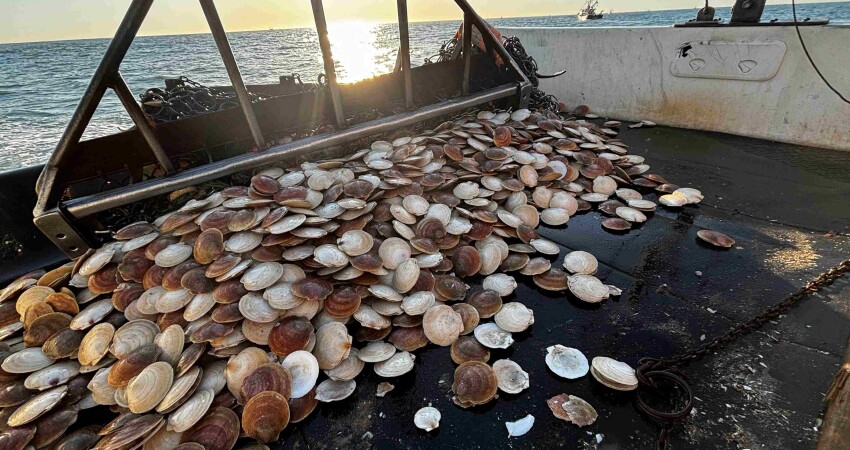The F/V Wizard, a 48-foot scallop boat from Jonesport, Maine, lies moored at Cape Ann Marina in Gloucester, Mass, America’s most historically renowned fishing port. In April, there is practically a Maine invasion of Gloucester, with an estimated 40 boats from as far as Lubec crowding the available moorings and setting out daily for Stellwagen Bank and a chance to catch 200 pounds of scallops.
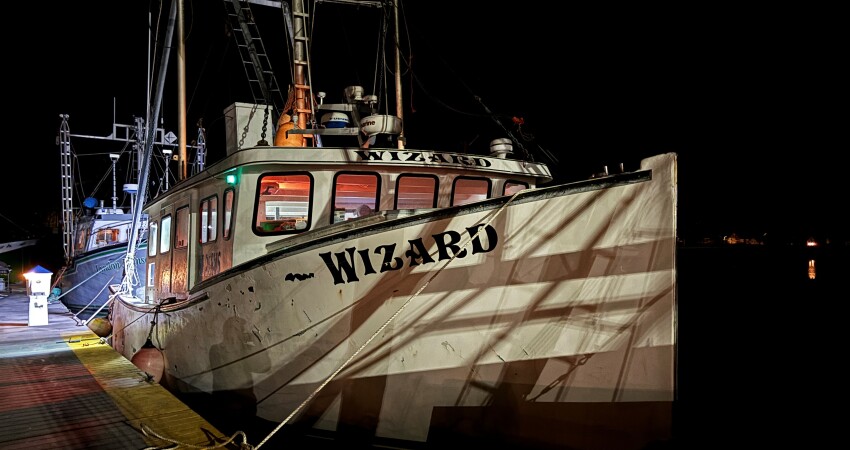
Rock Alley has spent most of his life as a lobsterman, but at age 67, he’s done. “I had a 46-foot Jarvis Newman; I sold it. I sold my federal permit, traps, everything,” said Alley. All I do now is scallop. I start in December in Maine and finish here.”
At 4:00 AM, Alley and his crew, 54-year-old Harris Norton and Norton’s 19-year-old son Caleb, set out for Stellwagen. “It’s two and a half hours out,” shared Alley. We’ll make a couple of tows and then turn around.”
“We’re usually in by 10:30 or 11:00,” said Harris Norton. “We make a couple of tows and fill that drag up right to the diamond. All 12 count.”
The owners of the Maine boats in Gloucester, along with those from Mass. and New Hampshire, all have Northern Gulf of Maine Scallop permits, for which most paid around $100,000. The permits enable them to participate in a limited fishery in which they can all land 200 pounds of scallop meat daily until they catch the 2024 quota of 454,152 pounds. “Last year, we only got 21 days,” said Alley. “But two years ago, we got 54. I’m hoping we’ll have about 28 this year.”
It’s the first really nice day since the season opened on April 1, and Harris Norton had an easy time making breakfast for the crew on the way out. With a flashlight clenched in his teeth, he cooked some bacon, fries, potatoes, and onions and scrambled some eggs. He brings a plate up to Alley, who is sitting at the helm. He, Caleb, and I help ourselves to the rest.
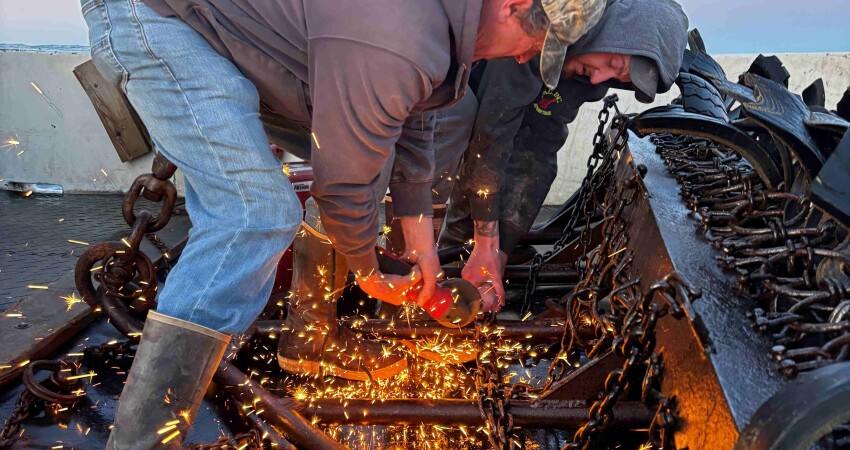
Dawn breaks at 5:30, and Harris and Caleb step on deck to do some minor repairs to the 9-foot-wide scallop dredge—a chain and steel ring bag with a mesh top hung from a steel triangle. When they’re ready to set out. Alley steps out of the wheelhouse to run the hydraulics. Opening a valve to one of the Pullmaster winches on the boom. He lifts the dredge, waits for it to swing out past the open stern, and drops it. On the winch break, Caleb lets out about 24 fathoms of wire and locks the brake down.
Alley’s electronics are minimal and straightforward: a Koden sounder, a Raymarine multi-function display for his radar and plotter, and a Sitex plotter. He has a Furuno satellite compass, a VHF, a non-functioning autopilot, and a radio tuned to a 1970s pop station. He doesn’t need much to make short tows in shallow water on beds rich with scallops. Towing at three and a half knots in water between 17 to 19 fathoms deep, Alley leaves the drag down for a little over five minutes before hauling back. After winding the dredge up to the A-frame that suspends it over the deck, Alley and his crew disappointedly looked at the meager haul. They dump it and set it out again. “Let out a few more fathoms this time,” Alley told Caleb, and they set the dredge again.
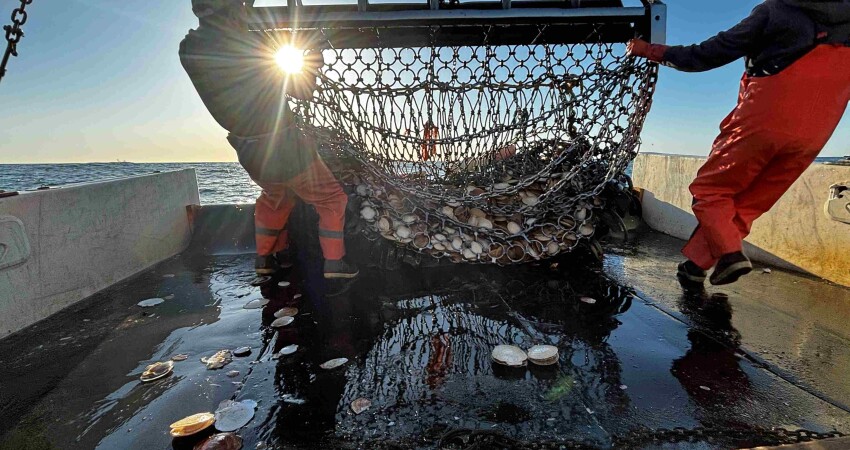
The scallops on deck are amazingly clean, with only a few basketball-size rocks and virtually no sand, mud, or gravel. The catch is so clean that rather than picking through a pile of seafloor and bycatch dumped on deck, Harris and Caleb shovel the scallops quickly into totes and baskets before dumping a couple of totes into their shucking box and beginning to cut them open. They work quickly, cutting off the top shell of each scallop, flipping off the guts, and cutting the medallion of meat into a small black pail that quickly fills with the glistening white meats.
They don’t get far into cutting before Alley hauls the dredge back again. This time, the twine top on the bag got snagged on the bail when they set, and the dredge didn’t fish properly. They dump the second meager bag and set again.
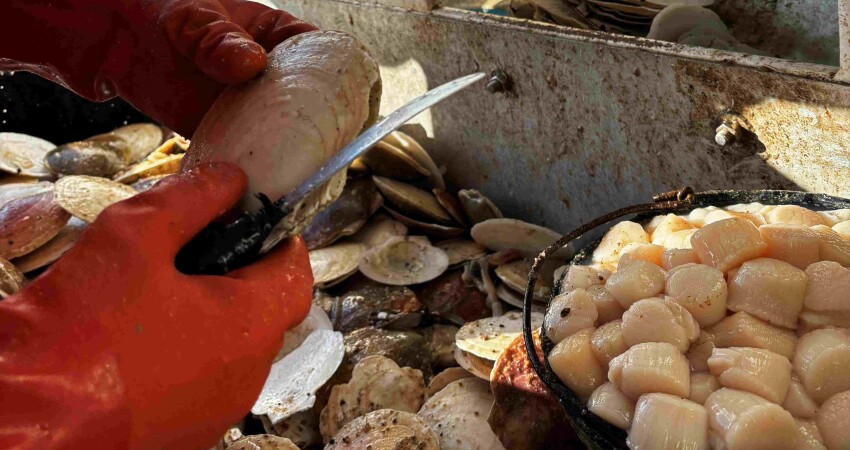
The third time is charmed, and they get a decent haul, filling all the baskets and totes they have, but still not enough to make 200 pounds. On the fourth tow they finally get it right. And the drag comes up full. “There we go,” said Harris. “I knew he could do it. Twenty bushel right there. We only need 28 bushel, we’ve figured. That’ll give us 200 pounds.”
Harris and his son cut away, filling their pails, and pouring them into buckets that will hold 50 pounds each. When they have four filled and rounded up, they stop cutting and start to wash and bag the scallops. Harris pours half a bucket into a plastic basket and uses the deck hose to wash the scallops. Caleb appears from the wheelhouse with a handful of bags and wire ties.
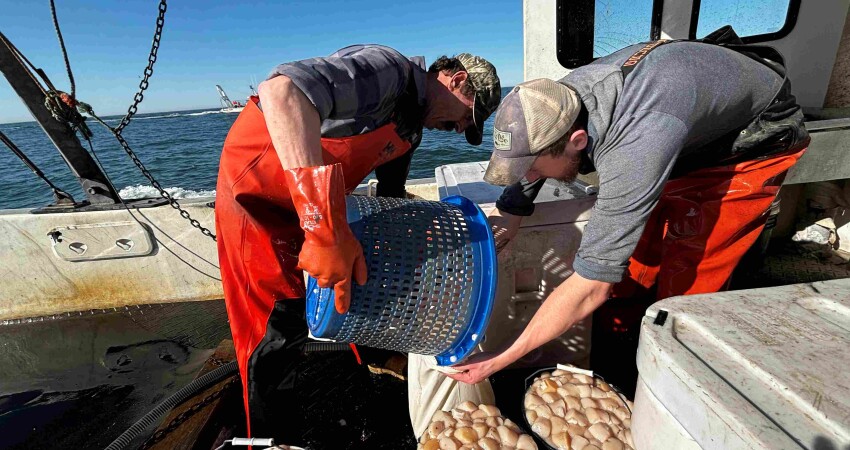
“Hold that open,” said Harris, pouring scallops from the basket into the bag. He then poured the rest of the buckets into the basket, washed them, and poured them into the bag. Caleb twisted a wire tight around the mouth of the bag and settled it into a bed of ice in a plastic box.
With the scallops stowed, Alley comes out on deck. “We have to dump everything we have on deck before we get inside three miles,” he said. He lifts the drag over the stern and watches as Harris hooks the cable from the Pullmaster onto a shackle on the end of a large rubber mat with a large pile of scallops still on it. Alley lifts the mat and watches the scallops slide back into the sea. While Harris shoveled the last scallops out of the corners on deck, Caleb shoveled them out of the shucking box and tossed them overboard.
It's barely 10:00, and Harris is peeling off his oil pants. “Easy duty,” he said.
Alley has made his trip report and submitted it electronically in accordance with the rules for this fishery. His report must include his operator’s permit number; his vessel trip report (VTR) serial number recorded from that trip's VTR; his estimate of weight to be landed, which is almost always 200 pounds of scallop meats; his landing location and time, and whether any scallops were caught in the NGOM.
Back in Gloucester, Alley makes the rounds, first unloading his scallops at Cape Ann Lobstermen, topping off his fuel with 216 gallons. “That’s five trips,” he said. “Do the math, about 43 gallons a trip.” Back at the Cape Ann Marina, the dock is full of Maine fishermen; everyone knows everyone, or at least they know people in common.
Alley walks back to his truck while his crew chats with other fishermen. “I don’t know what we’re getting paid yet,” he said. “But they’re paying $17 on the auction.”
Caleb reckons he’ll make $800 for the day. After the NGOM season ends, he and his father will return to lobstering, but not Alley. “I have seen the handwriting on the wall,” he shared. “I bought this boat down in Chatham two years ago. It has a 300-horse John Deere, a 3:1 Twin Disc gear, and a 36x36 wheel. But she tows alright.”
Regarding lobstering, Alley believes that conflicts with wind farms, aquaculture, and increasingly stringent regulations to protect whales will make it hard for him to keep going. But he’s happy scalloping, and the management system appears to keep this fishery healthy and lucrative.





